Characteristics
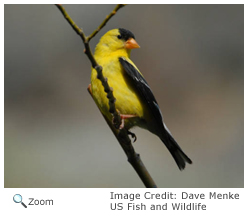 During mating season the male goldfinch has a bright yellow body, black wings with white stripes, a black cap on its head, and a white rump. During mating season the male goldfinch has a bright yellow body, black wings with white stripes, a black cap on its head, and a white rump.
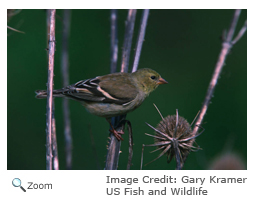 Females and winter males have duller feathers that are an olive-yellow color. The male's black cap may disappear in the winter or turn a dull black. Females don't have the black cap on their heads. Both males and females have a small cone-shaped bill. Females and winter males have duller feathers that are an olive-yellow color. The male's black cap may disappear in the winter or turn a dull black. Females don't have the black cap on their heads. Both males and females have a small cone-shaped bill.
Range
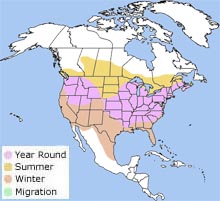 The goldfinch's winter and breeding range includes southern Canada, most of the continental United States and parts of Mexico. The goldfinch can be found year round on the upper east coast, on the west coast and in the mid-section of the United States. Northern populations winter in the southern U.S. and northern Mexico. The goldfinch's winter and breeding range includes southern Canada, most of the continental United States and parts of Mexico. The goldfinch can be found year round on the upper east coast, on the west coast and in the mid-section of the United States. Northern populations winter in the southern U.S. and northern Mexico.
Habitat
 The American goldfinch lives in weedy fields and floodplains as well as cultivated land, orchards and gardens. The American goldfinch lives in weedy fields and floodplains as well as cultivated land, orchards and gardens.
|
|
Diet
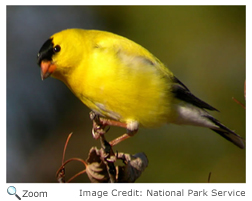 The goldfinch's diet is made up mostly of the seeds of grasses, weeds and other plants. It also eats the seeds of trees like birch, alder and elm. It feeds during the day. The goldfinch usually gets seeds that are still on the plant. Its long legs and claws help it easily perch on plants. The goldfinch's diet is made up mostly of the seeds of grasses, weeds and other plants. It also eats the seeds of trees like birch, alder and elm. It feeds during the day. The goldfinch usually gets seeds that are still on the plant. Its long legs and claws help it easily perch on plants.
Life Cycle
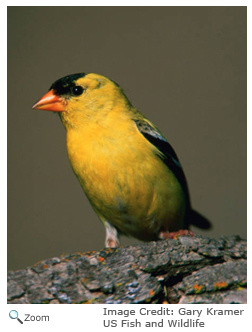 The goldfinch mates later than most birds. It is mainly a seed eater and it doesn't nest until mid-to late summer when there are lots of seeds from weeds and other plants. Because it mates so late in the year, it usually raises only one brood a year. The goldfinch mates later than most birds. It is mainly a seed eater and it doesn't nest until mid-to late summer when there are lots of seeds from weeds and other plants. Because it mates so late in the year, it usually raises only one brood a year.
The female builds a cup-shaped nest in the fork of a tree or bush while the male keeps watch. The nest is made of plant fibers and bark and takes about six days to build. The female lays between four to six light blue eggs. The male feeds the female while she incubates the eggs. The eggs hatch in about two weeks. The chicks are born naked and with their eyes closed. They open their eyes after about seven days. They will leave the nest when they are 10-16 days old.
Behavior
Goldfinches are very sociable and often gather in flocks with other birds. Some populations are short-distance migrators and move south in the winter.
|